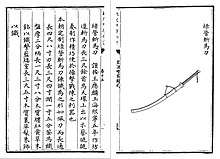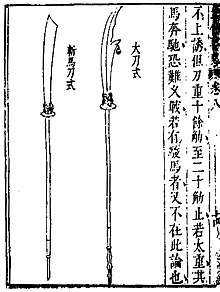Zhanmadao
The zhanmadao (Chinese: 斬馬刀; pinyin: zhǎnmǎdāo; lit.: 'horse chopping saber') was a single-bladed anti-cavalry Chinese sword. It originated during the Han Dynasty (206 BC – 220 AD) and was especially common in Song China (960–1279).
| Zhanmadao (斬馬刀) | |
|---|---|
 A zhanmadao "horse butchering dao" from a Qing dynasty illustration, 1766 | |
| Type | Infantry anti-cavalry saber |
| Place of origin | Han dynasty, China |
| Production history | |
| Variants | Possible changdao, miaodao, wodao, zanbatō |
| Specifications | |
| Length | Approx 200+ cm |
| Blade length | Approx 150+ cm |
| Blade type | Single edged, straight for most of the length, curving in the last third. |
| Hilt type | Two handed |

General characteristics
The zhanmadao is a sabre with a single long broad blade, and a long handle suitable for two-handed use. It was used as an anti-cavalry weapon, dating from Emperor Cheng of Han, made to slice through a horse's legs.[1] This is mentioned in the "Wu Jing Zong Yao" a Song Military Manual from 1072.[2] It featured prominently against the Jin armies in campaigns between 1129 and 1141.[3]
There was also an earlier weapon called the zhanmajian "horse beheading jian" that existed during the Han dynasty, so called because it was supposedly able to cut off a horse's head.[4] However, another source says that it was an execution tool used on special occasions rather than a military weapon.[5]
Surviving examples include a sword that might resemble a nagamaki in construction; it had a wrapped handle 37 centimetres long making it easy to grip with two hands. The blade was 114 centimetres long and very straight with a slight curve in the last half.
Similar weapons
Possible variations of these Chinese swords were the changdao, miaodao, and wodao. The sword may have been the inspiration for the Japanese zanbatō; both are written with the same characters and have been said to have been used for killing the horse and rider in one swing.[6]
See also
References
- Yang, Jwing-Ming (1 March 1999). Ancient Chinese Weapons: A Martial Artist's Guide. YMAA Publication Center Inc. p. 65. ISBN 978-1-886969-67-4. Retrieved 27 January 2013.
- "The Mongol Siege of Xiangyang and Fan-ch'eng and the Song military". deremilitari.org. Retrieved 6 November 2010.
- Scott, Richard Bodley; Gaukroger, Nik (22 September 2009). Empires of the Dragon: The Far East at War. Osprey Publishing. p. 107. ISBN 978-1-84603-690-3. Retrieved 27 January 2013.
- Lorge 2011, p. 103.
- Zhan Ma Dao (斬馬刀), retrieved 15 April 2018
- Breverton, Terry (26 April 2012). Breverton's Encyclopedia of Inventions: A Compendium of Technological Leaps, Groundbreaking Discoveries and Scientific Breakthroughs that Changed the World. Quercus Publishing. p. 18. ISBN 978-1-78087-340-4. Retrieved 27 January 2013.
